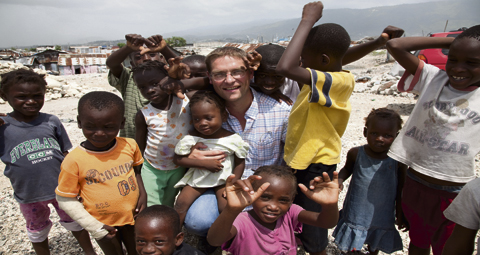July 25 | ![]() 0 COMMENTS
0 COMMENTS ![]() print
print

Food is making it better in Haiti
MAGNUS MacFarlane-Barrow, founder and CEO of Mary’s Meals, reflects on a recent visit to Haiti, where the charity’s school feeding programme reaches 26,201 children with a nutritious daily meal in a place of education
All over the school, homemade posters make statements about Mary’s Meals. On a balcony above the central courtyard three boys lean through the railings to attach a banner that reads ‘No Education without Food.’ Flowers adorn a doorway on which is written ‘Welcome Magnus and Mary’s Meals,’ while in the kitchen a team of cooks wearing Mary’s Meals aprons work under a huge painted sign that says ‘Thank You Mary’s Meals.’ It seems that, in this school, they know a thing or two about branding.
It is over two years since I was in Cité Soleil, one of the world’s most notorious slums, where over 6000 children eat Mary’s Meals every day. The schools here were built—and rebuilt with our help after the earthquake—by our old friends Fr Tom Hagan and Doug Campbell who founded Hands Together, our partner in Haiti. Cité Soleil is home to hundreds of thousands of people, living mainly in makeshift huts on what was a rubbish dump, without running water or sanitation.
On the previous day, we were up in the central plateaux of Haiti to visit schools that had urgently requested Mary’s Meals. We drove into the hills, up a road that became steeper and narrower and eventually petered out altogether. We walked on for 15 minutes up a mountain path, until we came to a little school of stick buildings with thatched roofs.
In the ‘Centre du Savio’ (Centre of Knowledge), 172 pupils were being taught by six teachers. The children were hungry. It was early afternoon and they had not yet eaten that day. Some had walked for over an hour to get there, and faced that long trek home later on empty stomachs. Previously they were given school meals by another organisation but that stopped nearly two years ago. When we asked them to tell us how they felt they looked at each other shyly until a girl in the front row spoke up.
“No one has energy now,” Felius said quietly. “No one plays at break time anymore. We are hungry all day. Sometimes pupils fall asleep in class.”
Back in Cité Soleil the kids have eaten their plates of rice, beans and fish. There is no shortage of energy here and an air of excitement pervades the school. We learn that the posters are only part of the welcome. They have, in fact, organised a concert for us. A choir sings a wonderful song they have written about Mary’s Meals and then two older boys who are astonishing break dancers entertain us with their dazzling moves. Then, to my great surprise, Jimmy climbs on to the stage and takes the microphone.
I last met Jimmy two years ago when he was head boy of this school and we interviewed him about his life. He impressed me hugely then with his intelligence and his positive approach. Today he addresses us and the assembly of pupils from his former school with passion and confidence. He tells us that he received Mary’s Meals for many years. He said that he has now figured out that the food helped him physically, morally and spiritually; it gave his body strength, made him think about sharing with others and led him to think about the ‘yes’ of Mary and the ‘yes’ of all those who serve Mary’s Meals.
For a moment his smiling and swagger dropped and he became emotional. As he left the stage his audience roared their approval and clapped loudly. Jimmy, who today works for Hands Together, is clearly popular in these parts.
As soon as the concert finished, Fr Hagan took us to see one more Mary’s Meals project. He began to invite the ‘barefoot children’ who live on the streets—and who are, most certainly, the poorest of the very poor—in for a meal. Some were naked when they first came, but Fr Hagan had provided them with clothing. They turn up for a meal after regular classes have finished and, after eating, are taught for two hours by youngsters who have left this school the previous year and who have now returned as volunteers to ‘give something back.’
One of them is 21-year-old Francois. Wearing a white shirt and a bright blue tie, he points at the letters on the blackboard and speaks to the ragged skinny children in front of him with a broad smile. He tells us he loves teaching these children. Since they began this project the number of children coming keeps growing. Today, in addition to the 5189 regular school pupils, 1353 children from the streets also tucked into a large plate of rice, fish and beans.
As we finally leave the school I notice one more poster amongst the hundreds of carefully handwritten signs that adorn this school proclaiming gratitude and love for Mary’s Meals. It says simply, with a little spelling mistake, ‘Food Maks It Better.’ Indeed it does.
—www.marysmeals.org.uk
PIC: CHRIS LESLIE











